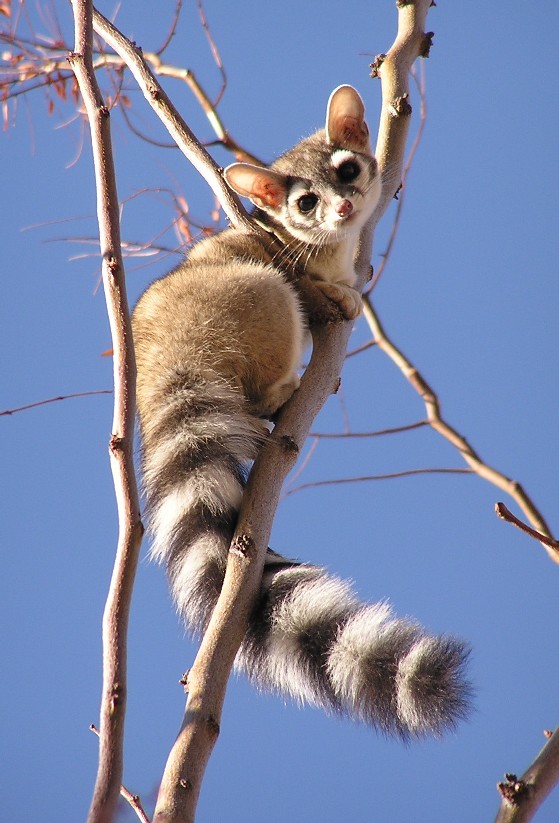Bassariscus astutus

Ringtails are adept climbers. Photo by Craig Benkman.
The ring-tailed cat (or miner’s cat) is not actually a cat — rather, it is a small, fox-sized member of the raccoon family with a long, striped tail. It is native to the southwestern United States (including the Los Padres National Forest) and Mexico. Solely nocturnal, the ringtail is so elusive that biologists don’t really know if their populations are healthy or threatened in our region.
Biology and Behavior
Ring-tailed cats often inhabit ecosystems such as oak forests, chaparral, deserts, and rocky canyons. Because these ecosystems are normally hot, arid areas with little available water during most seasons, ring-tailed cats are specially adapted to overcome these challenges. Ringtails are nocturnal so that they are most active when the air is cooler and they rest during the heat of the day in their dens. Ringtails do not construct their own dens because they constantly change them every two to three days to avoid predators. Rather, they attempt to find shelter in rock crevices, hollow trees, logs, or beneath dense shrubs. In order to overcome water stress, ringtails are incredibly water efficient and produce very little liquid waste. Additionally, ringtails are remarkably agile climbers and can even rotate their hind paws 180 degrees to allow for headfirst vertical descents.
The ring-tailed cat breeds between February and May and births occur in a den from May to June with litters typically consisting of one to four young. These young are completely dependent and do not even open their eyes until they are more than three weeks old, do not take solid food until about seven weeks old, and are not fully weaned by eight to ten weeks old. During this time, the mother must regularly move her young from den to den to avoid predators such as coyotes, raccoons, owls, and bobcats. At two months old, the young ring-tailed cats are ready to enter the world and begin foraging with their mother. Shortly after, the ring-tailed cats are ready to live on their own and remain solitary throughout their life, only interacting with other ringtails to breed or share the occasional den.
As a nocturnal carnivore, ring-tailed cats forage at night for a variety of prey, including small mammals, invertebrates, birds, and reptiles. Additionally, the ringtail may supplement its diet with plants or fruit, though meat tends to make up the bulk of its diet. By filling this ecological niche, the ring-tailed cat plays an important ecosystem role of regulating the populations of its prey and assisting in seed dispersal.
Threats
Ring-tailed cats were once common, but their extensive population began to decline as the West was colonized. Many early settlers took to fur trapping to make a living on the frontier, and trappers targeted ring-tailed cats as an easy-to-obtain knock-off of the favored raccoon pelt, which was the most drastic cause of decline. However, people began to domesticate the ring-tailed cat, offering it a warm and comfortable place to den in exchange for catching mice in the area. Because of this, ringtails were given the alternative name of “miner’s cat.” When the extensive trapping eventually led to a drastic decline in ringtail populations, the California Department of Fish & Game added the ring-tailed cat to the state’s list of “fully protected species,” thereby prohibiting the harming or possession of ringtails under any circumstances.

Ringtail cat found in western part of its range. Photo © Robert Body
Today, while the ring-tailed cat is common and widespread throughout much of the southwest and populations in California are thought to be recovering from heavy declines due to fur trapping, there remains very little research or understanding of current population trends and distribution–which experts agree is cause for concern. And while fur trapping of ringtails has virtually ceased, individuals are still at risk of collisions with vehicles, contraction of disease from stray cats and dogs, and destruction of den habitat.






